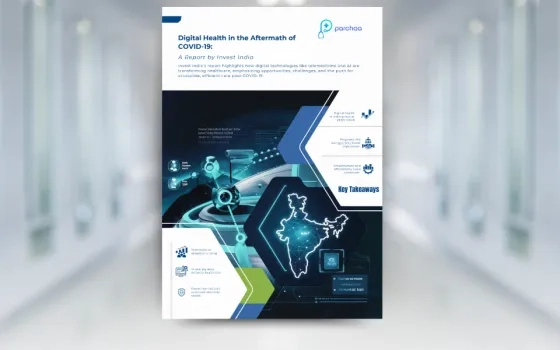‘Leading in Crisis’ is one of the most discussed themes from the last two years, be it technology, business, or public sector space.
Today, the world is appreciating India’s remarkable achievement of crossing the 100 crore vaccine target, which is an important milestone in its continued efforts. On a global level, a massive vaccination campaign is going on too. As of date, more than 6.86 billion vaccinations across 184 countries have been given, and with an average daily rate of 32 million doses, approx 37.6% of the world’s population is now fully vaccinated.
These numbers are indeed encouraging and give hope, but the real message for humanity does not lie in the stats alone.
Every country, company, or individual that has tackled the corona pandemic and bounced back to the normality in life is a leader on its own, and its efforts have somewhere contributed toward this ongoing battle for humanity.
In the world of business, it is often said that when one survives a ‘near-death experience,’ that experience makes him unstoppable, and nothing in the world can beat you again. It is something that perfectly fits in the case of India. The way India has not only survived but bounced back to its trajectory gives hope to many in the world.
The questions today in everyone’s mind are: How a country of billion plus people has done it? And what are some of the best practices to learn from India’s experience?
But before exploring the answers, it is crucial to recall the scale and depth of the crisis first.
The ‘Crisis’
“We have never seen or heard of such a crisis. This crisis is unthinkable as well as unprecedented for mankind,” said PM Modi in his address to the nation in May 2020. He communicated a clear message about the seriousness of the crisis to the nation but at the same time motivated every individual to prepare his mind with a wartime spirit to deal with this challenge.
But exactly what was the nature of the crisis?
A majority of discussions on the corona crisis tend to stick around the analysis on the Virus, its containment, management, ongoing vaccination efforts, the possibilities of new variants, and their spread. These aspects are important but once initiated, the real crisis is already far beyond the ‘Virus’ itself.
In the Arthashastra, Acharya Chanakya has said: “When the calamities of a single element tend to destroy the rest of the elements, those calamities, whether they are of the fundamental or any other element, are verily serious.”
For many countries including ours, it was a kind of a multi-front war with an invisible enemy. It brought enormous pressure on almost all dimensions of social-economic life and created new kinds of political and national security challenges.
Shutting the lives and livelihoods of a billion-plus people was not a normal task. Many tagged that initial phase of corona as the worst recession and slowest economic downturn witnessed ever since Independence. Almost all major global agencies slashed India’s growth figures dramatically. Within a few days of corona restrictions, all core economic activities fell badly, production/manufacturing went to a halt, unemployment tripled, millions of people lost their means of earnings and that resulted in the massive drops in household income too, which was the lowest drop in decades. Sustaining the core force of our economy, the informal sector, small businesses, and their workforce- the migration workers was also a big challenge before the government.
While India was not alone in this crisis, with some degree of fluctuations in scale, almost the entire world was under major economic stress. But more than the economic stress, what India faced was something different and new.
There are occasions in the life of a nation when it is expected that even the opposition parties will play a constructive role and the Covid pandemic was one such time. Unfortunately, the approach of India's opposition was a complete departure from this expectation.
The colonial-era tendencies of tagging a crisis or national calamity as the crisis on the political establishment attempted to derail many of the positive moves/reforms of the government. Several negative and disinformation campaigns were launched in the middle of the crisis to tarnish the country’s image and to project this global scourge as the Indian government’s mismanagement of the situation. Somewhere there was an eagerness to celebrate the anticipated economic bankruptcy and social disorder, and there were occasions when some of those efforts joined hands with the external elements/lobby groups too.
Amid all these challenges, the extremist and expansionist forces from two sides of the borders started more aggressive campaigns to take advantage of the situation.
In a way, the Crisis that India went through was multidimensional, but what is more important here to note is that the country has recovered from that phase at a much faster pace than expected.
The Leadership
India is blessed that it has a leader whose experience in dealing with crisis and disasters are quite rich. PM Modi has witnessed the Gujarat 2001 earthquake (also known as the Bhuj earthquake) as the chief minister of the state. With 7.7 of Richter magnitude scale, it was one of the most severe disasters of our times. The destruction was widespread, 21 out of 25 districts and over 700 villages of Gujarat were affected. And the Kutch was among the five districts which were severely destroyed, the district accounted for about 88% of the deaths.
In his book “The Kutch Earthquake 2001- Recollection, Lessons and Insights,” Shri Pramod K Mishra Ji writes that “In spite of the immediate sense of shock, confusion, helplessness and grief, the government and the community rose to the occasion and quickly responded to the event that had overwhelmed them.“ And “the scale of the rescue and relief operation was unprecedented.” It is interesting here to note that the reforms in Gujarat State Disaster Management Act in 2003 later become the foundation for the National Disaster Management Act (enacted in 2005). Today, it is the same Act that has helped in saving millions of lives during the corona pandemic.
To some extent, the way India’s leadership team has tackled the situation and could efficiently manage this massive crisis, in that the experiences and lessons learned from the Gujarat earthquake have an important role.
Preparing the 'Minds'
It is often said that in a national crisis it is necessary to make the people aware of the reality, and this is something which all developed countries have done in their part of the world too. But this approach is for normal to medium scale crises/challenges in national life, this time the situation was a bit different.
When you are in a war, you don't just face reality, but you have to be prepared to fight it, with full force and spirit too! And the situation was in no way less devastating than a War.
In the initial stages of the corona pandemic, there were experts (inside and outside the country) who expressed their concerns regarding the lack of discipline and restraint that India needed to tackle such a crisis. But from the beginning, PM Modi has complete trust in the sense and moral abilities of the common citizens of India. He appealed to the citizens to follow a 14 hour long ‘Janta Curfew’ (People’s curfew) on 22nd March which he said: “will be a symbol of our effort, of our self-restraint, and our resolve to fulfill our duty in service of the nation.”
In a warlike situation, the role of Spirit is crucial. When the whole country clapped, banged thalis, and lit lamps together it demonstrated a different kind of spirit, solidarity, energy, and moral preparedness. That event came as a surprise to many that instead of getting panicked, the people of India are more prepared to face the challenges as they come.
The Power of Collective Efforts
Active public participation in governance delivery that India has nurtured over the last few years proved the key force in its fight against the pandemic.
The crisis is a test for the character of an individual, society, and nation. It was during this time, India exhibited its integral elements of unity and everyone cooperated like the members of one large family.
Within a few days of the lockdown, from frontline workers to common people to socio-religious groups to businesses, almost everyone took the command of fighting this battle on different fronts. Several community kitchens and shelters were rolled out, many people distributed self-prepared kits of grocery items to the needy and even some had started offering their private places as the quarantine facility to the government.
Businesses of all sizes, despite serious financial stress together with different religious groups and several Hindu temples across the country, came forward to contribute with an open heart to the PM-CARES fund (Prime Minister’s Citizen Assistance and Relief in Emergency Situations Fund). And for this no orders were issued, these were all the self-motivated efforts of the individuals/groups and society.
Role of Technology and Innovation
“It is a matter of pride for all of us that the entire vaccination program of India has been science-born, science-driven, and science-based,” said PM Modi in the address to the nation on the achievement of 100 crore vaccination mark.
Today, India has the world’s biggest digitally connected infrastructure and this digital infra proved invaluable in pushing back the pandemic too. Whether it’s about providing the food rations to 800 million people, regular cash transfers to 400 million, disbursement of different government benefits through Direct Benefit Transfer, use of GeM platform for government procurement, UPI backed digital payment ecosystem or accelerated contact tracing, online and mobile-based diagnosis through Arogya Setu App and now vaccination delivery and management platform CoWIN, etc. all these platforms and tools have added an extraordinary speed in the government’s efforts and ensured that the cycle of last-mile delivery of services remains uninterrupted.
When corona started there was a complete vacuum for made-in-India items for many necessities such as PPE kits, testing kits, and N95 masks, but within a matter of few months, the country not only innovated and produced the homegrown better versions but started providing these supplies to other countries as well. On one hand, this is an example of turning a crisis into an opportunity, on the other hand, this can be called a phase when India has provided a template for the responsible use of technology and innovation to the world.
Hope for the Future
“When India grows, the world grows. When India reforms, the world transforms” said PM Modi in his recent UNGA address. Even the pandemic could not stop the trajectory of reforms in India. It was during this period the country saw all-around reforms in almost all key sectors, ranging from manufacturing to MSME to agriculture to infrastructure, from technology to taxation, from defense to space, from energy to clean water, from regulatory easing to real estate. Whether it is the opening up of the space sector for the private sector, historic policy reforms in the mapping and geospatial sector, liberalized drone rules 2021, the appointment of India’s first Chief of Defence Staff (CDS), and creation of the Department of Military Affairs, corporatization of Ordnance Factory Board and creation of seven new defense companies, launch of five Young Scientists Laboratories of DRDO, reforms in NCC, and reforms increasing participation of women in the Armed forces, launching of over 100 plus Kisan rails, the launch of Ayushman Bharat Digital Mission, National Health Mission, eRupi, Ujjwala 2.0, along with several developments and infrastructure-related initiatives in different states of the country.
A few days back while unveiling the PM Gati Shakti National Master Plan, PM Modi has said: Today's mantra is – ‘Will for Progress’, ‘Work for Progress’, ‘Wealth for Progress’, ‘Plan for Progress’ and ‘Preference for Progress’.
From covid management to vaccination efforts, anyone who is familiar with the diversity and complexity of India’s geographical as well as socio-economic structure would agree that there are several small or big moves of the country that are encouraging and they are presenting a new example and model of governance, which can be useful for other parts of the world too.
Today, there is new hope and positivity in the environment and India is a true torchbearer of that hope.

















